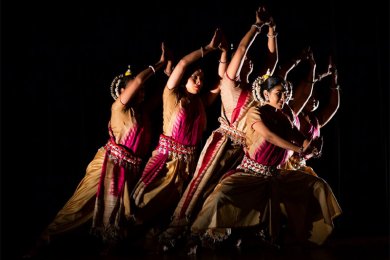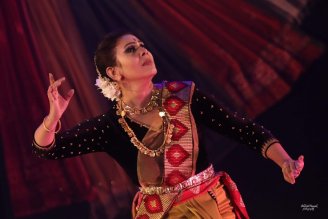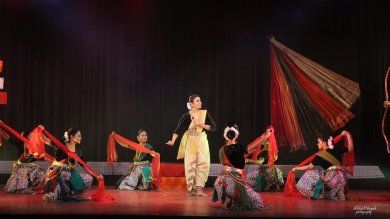
|   |

|   |
 e-mail: ukb7@rediffmail.com Delving tradition, deconstructing Ramayana November 18, 2018 Post-Independence, India has seen not merely an upsurge in its consolidation of eight recognised classical dance forms (and a few more waiting in the wings for formal recognition), but also a succession of gurus who have held the cudgels in their capable hands and led the ever increasing batches of learners - in India and in the diaspora abroad, keen to bond with cultural roots they had left behind - over the years. The first generation gurus have been, without exception, trail blazers and have left their stamp on the individual dance forms. An eager batch of new learners - marked by talents and quite often handpicked by the gurus -- were initiated into the mystique of canons of, and choreography in, their styles and have now transformed themselves into worthy second generation gurus in all the eight forms. It is with immense pleasure that one watches the scenario that heralds the emergence of third generation gurus, for, the show must go on. 

Shashwati Garai Ghosh and ensemble
Presented on October 13 in Kolkata by 'Anga Shuddhi - Home of Odissi',
Sampriti was a reaffirmation of the gratifying fact that, among the bevy
of second generation gurus created by the legendary Odissi guru
Kelubabu, Sharmila Biswas is undoubtedly a worthy torchbearer of his
gharana. She has now paved the way of creating her own band of
meritorious students -- like Shashwati Garai Ghosh -- who have begun
creating their own choreography. Ekatra (Togetherness) was Shashwati's
own ensemble of dances executed by her well-trained students that
explored new dimensions of colours and vibrations, and was quite an
honest effort to carry on the legacy passed down to the new generation
of gurus. Supported throughout by imaginative music composed by Srijan Chatterjee, the oeuvre began with two devotional items, first a Vishnu Stuti written by Bharathi Teertha Swamy, invoking supreme consciousness and a sense of harmony. And then came a Vinayaka Stuti, celebrating the grandeur of Gajanana as a benefactor for education, welfare and wealth. Taking inspiration from sculpture of dancers and musicians on Odisha temple walls, there followed Sthai Nato, demonstrating rare intricacies of Odissi's bhramaris, charis and utplavanas, a la guru Deba Prasad Das. If this item stuck to the Gotipua tradition of the young male dancers, the next was a lilting Mahari Nacho, following the tradition of female temple dancers of Odisha, a composition by Sharmila Biswas, echoing guru Kelubabu. Nata Nagaro was a playful item visualising the pranks of the youthful Krishna vis-à-vis the enraptured Gopis, with the pastoral god's anklets, peacock crown and tribhangi postures, playing the flute. The ensemble's concluding item was Sama, a dance piece capturing the fluidity to transform the masculine persona (imaged on Shiva) into the feminine persona (imaged on Radha) and vice versa. By any imagination, the aesthetics of the reversal of male-female roles is quite a difficult task, to underline the subtleties of the mannerisms with grace and conviction. This was, nonetheless, very well done. The finale was a reverting back to Sharmila Biswas's masterly composition Maya Manav performed as solo by Shashwati. With music by Ramesh Chandra Das and Bijaykumar Barik, she chose the episode of Rama and the magical golden deer from Bichitra Ramayana, a well-known medieval literary work by Biswanath Khuntia. Often used as a metaphor about the perpetual human quest for the unattainable, Shashwati took it to the level of man's eternal journeyto unravel the mystery of Maya (the Illusion) which encompasses this world. She depicted how Maya always wins, leaving man confused and frustrated, but still optimistic - though never quite able to overcome the attraction of Maya. Shashwati did a superb job in her ekaharya abhinaya, showing a high level of artistry. Quite evidently, Kelubabu's legacy - via Sharmila's imaginative touches - is in good hands in the new generation. 

Sampurna
Photos: Abhijit Nayak photography Presented on November 2 in Kolkata by 'Dhriti Nartanalaya' from the neighbourhood country of Bangladesh, Sampurna- a Woman's Journey of Strength was yet another affirmation how the classical dance tradition of this sub-continent has spread its roots far and wide. Warda Rehab, who conceived and choreographed the dance-drama, is a virtuoso Manipuri dancer, first trained by Sharmila Banerjee and later fully groomed by their Guru Kalavati Devi - both carrying on the mantle of the first generation Manipuri Guru Bipin Singh - in her dance form. Having further completed her graduate and post-graduate dance studies from Rabindra Bharati University with top academic honours, Warda is now a new generation guru in her own right and running her dance organisation with many an acclaimed production - performed in the subcontinent and overseas - to her credit. Scripted by Shipra Paul with music by Suman Sarkar, Sampurna offered insight into the venerated epic of Ramayana, entirely from the standpoint of Sita, a symbol of a powerful woman, who not only had a firm grip over her own life, but also greatly influenced events and personalities of the epic with her strong convictions and ideas. This was unveiled in a capsuled gripping story of Rama's relationship with Sita and, through her, his relationship with the subjects of Ayodhya who did not take kindly to their queen who had spent a long time in captivity under the powers of the evil king of Lanka. Warda opines, "Most women would find resonance with various life events of Sita. Very often these insightful references would guide today's women to take decisions in their daily life. One would be amazed by the fact that a story, perhaps as old as mankind itself, has still echoes and pathos of the entire womankind belonging to all ages. We, the women, do face very similar dilemmas still in our lives, which she felt thousands of years ago." The choreographer also pointedly asks, "Can one imagine how deep-rooted our conditioning would be? Probably that is what makes it very difficult for us to change them. Sita's own luminous strength determined her identity and self-respect. It was not her weakness, but an inner strength of womanhood and self-respect that made her to choose the path of sacrifice. She had immense reserves of inner strength reflected in her patience, forgiveness and love. Despite endless questioning she faced that led to her suffering, Sita calmly faced any situation that she came across and every day a litmus test was conducted where she had to prove the test. Strikingly, these would be much like ordeals for any woman in common life and she would be expected to do exactly the same to prove herself!" The production was in pristine pure Manipuri style with one male and six female dancers besides Warda. The latter's choreography was imaginative and vigorous, quite often borrowing from pung cholam, thang ta and Lai Haraoba, a la Guru Bipin Singh's legacy. After Warda and her group summarily presented the main events of the epic, the group sought to visualise Sita's trials and triumphs, liberally drawing from Rabindranath Tagore and Kazi Nazrul Islam. Thus came the searching question: Why won't you allow woman to decide her own fate, my lord... and The bewildered hesitation in the face of abuse is demeaning oneself...Nazrul's rare lyric, Jaya Site..., never set to music by the ailing poet, was narrated as a hymn and visualised as a scintillating group composition. The finale was another thundering proclamation in Tagore's Chitrangada by the protagonist to Arjuna: I'm not just any woman to be slighted and shoved behind; only if you keep me beside you and let me share in every deed of yours, you'll recognise and redeem my true worth... Sampurna fully earned audience's approbation, as aptly summarised by Warda, "Sita did not see herself as a victim. She was a superior human soul, silently suffering and enduring patience like that of Earth itself made her the touchstone of morality. Sita is the portrayal of all womanhood and reflection of the heart of every woman of this planet."  Dr. Utpal K Banerjee is a scholar-commentator on performing arts over last four decades. He has authored 23 books on Indian art and culture, and 10 on Tagore studies. He served IGNCA as National Project Director, was a Tagore Research Scholar and is recipient of Padma Shri. Post your comments Please provide your name and email id when you use the Anonymous profile in the blog to post a comment. All appropriate comments posted with name & email id in the blog will also be featured in the site. |